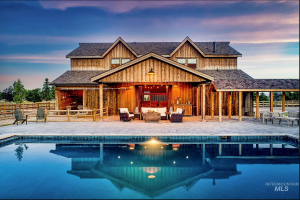In my past life I lived with my family in Oregon’s Willamette Valley. Hot summer days filled with sunshine were about as rare as access to nearby lakes – close to zero. Having grown up spending summers at my maternal grandparents’ lake cabin, swimming has always been part of my life. A frequently told fable was my younger brother and I could swim before we could walk!
Given relatively mild winter weather, I opted to have an in-ground outdoor swimming pool added to our backyard. Many an hour was spent in this pool, prior to selling and moving back to my native Spokane area.
Reader CLINT in COLUMBUS writes:
“Saw a post about pole barn over an in ground pool.
Curious about moisture management? My pool builder says a lot of cost but won’t expand on it.”
 Mike the Pole Barn Guru responds:
Mike the Pole Barn Guru responds:
Indoor pools demand special monitoring for constant challenge of humidity control. Service pros shouldn’t be expected to maintain dehumidifiers, which are HVAC/R machines requiring EPA-certified technicians. Indoor pools can malfunction quickly, so a typical six-month or annual dehumidifier check-up by an HVAC/R service contractor isn’t enough to detect potentially damaging problems before they blossom.
An indoor pool is a unique synergy of four factors, degradation of any could result in building deterioration, air quality health problems and uncomfortable environmental conditions for users.
1. Building envelope: Indoor pools can experience issues related to construction techniques or building materials. For example, missing or breached vapor barriers can allow damaging condensation to accumulate inside walls. For post frame pool covers, I would recommend use of all pressure preservative treated lumber. Walls must have a totally sealed interior vapor barrier. Depending upon climate, adding a layer of two inch closed cell rigid insulation board to inside of framing reduces thermal transmission between interior and exterior and can be air sealed.
2. Ventilation: Supply air ducts and vents must fully cover exterior windows with conditioned air to avoid condensation. System must move air down to breathing zone for good air quality.
3. Dehumidification: Most indoor pool spaces have a dehumidifier to maintain 50- to 60 percent relative humidity and cool or heat air to a set point temperature. Without it, the space probably depends on outdoor air and exhaust.
4. Water chemistry: Imbalanced chemistry results in buildup of respiratory-affecting chloramines and potentially causing surfaces to corrode.
Most modern dehumidifiers are complete HVAC machines heating or cooling space and use compressor heat recovery to heat pool water.
So space and water temperatures, and relative humidity are key checkpoints. These parameters are displayed on a microprocessor’s LED keypad readout and in many cases can be accessed remotely. A good rule of thumb is to keep a two-degree difference between space (higher) and water (lower) temperatures. A common indoor pool set point is 84°F space, 82°F water temperature and a 60 percent relative humidity. Lowering space temperature by even two degrees increases humidity load by 35 percent, which could surpass a dehumidifier’s capacity.
Many dehumidifier LED keypads have red warning lights to indicate an operation stoppage or problems, which only an HVAC/R technician can repair. This readout menu can be scrolled to find a cause.
No water should leak from inlets or outlets of dehumidifiers with a pool water heating feature. On the other hand, hundreds of pool water heating models have been errantly left unconnected to the pool’s circulation systems. Owners should know water heating connection to a dehumidifier could save hundreds of dollars on utility bills annually.
An overflowing condensate drain pan (or watermark evidence) could point to a potentially damaging drain line blockage.
Condensation on exterior walls and ceilings should not occur. Window and skylight condensation indicates the glass is not covered with warm dehumidified supply air and its temperature has dropped below the dew point.
Premature corrosion on door hardware or room surfaces could indicate a problem.
Indoor pools must operate with a negative building pressure: Approximately 10 percent more air volume should be exhausted than introduced. A malfunctioning exhaust fan or ventilation design can result in positive pressure and push pool air and odors into connected living quarters. Positive pressurization also can push moisture into poorly sealed voids inside walls and above ceilings where it can produce mold and deteriorate the building. Indoor pool building pressure can be easily checked by slightly opening a door and seeing if air is being pulled in (negative) or pushed out (positive).
Dehumidifier supply air blowers generally run 24/7 to offset pool evaporation, so monthly or bi-monthly air-filter replacements may be needed. If the blower isn’t running, there’s something amiss.
Dehumidifier compressors run at least 10 minutes at a time. Hearing compressor short-cycle off and on several times within a minute or two warrants an HVAC/R service contractor’s attention. Very noisy ductwork, such as drum head effects and extreme vibrations, could point to a poor ventilation design. Unusual sounds, such as fan belts squealing or worn out motor or blower bearings, also require an HVAC/R contractor.
A final note: Suggesting owners call their dehumidifier maker rather than an HVAC/R contractor usually won’t help because they rarely perform repairs. However, a factory tech’s review of data can help HVAC/R service pros troubleshoot issues.






